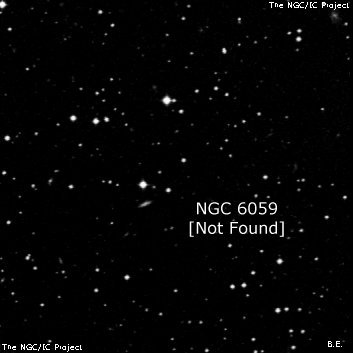NGC/IC Project Restoration Effort
(This is a very very beta version)
NGC6059


Basic Information
Location and Magnitude
Right Ascension: 16:7:13.2
Declination: -6:24:47
Constellation: OPH
Visual Magnitude:
Historic Information
Discoverer: Swift L.
Year of discovery: 1886
Discovery aperture: 16.0
Observational
Summary description: vF, S, R
Sub-type: NF
Corwin's Notes
=====
NGC 6059. Earlier, when I looked for this object, I had this to say about
it:
This object is probably lost for good. I could not find it for SEGC, and
there are no galaxies at reasonable offsets from the nominal position that
Swift might have seen. His complete description was copied intact into NGC,
and his position was correctly precessed, so the original paper was no help
in this case.
The IC1 note is another curiosity about the field: there is nothing at
Bigourdan's "revised" position, either (16 07 23.8, -06 27 08; J2000).
There are a few faint stars and even fainter galaxies in the area, but
nothing that Bigourdan could have seen. He comments under his observation
of IC 4589 (which see), "I do not see another object which can be taken for
NGC 6059, which, all in all, does not appear to be seen."
Finally, there are no systematic offsets in Swift's positions for the night
of 6 May 1886 that might lead us to a galaxy. Another (N4280, which see) of
those objects, though, is also probably lost.
In July of 2009, Jeffrey Corder, based on visual observations with his 17.5-
inch reflector, suggested two candidates for Swift's object. One, a triple
star at 16 07 42.5 -06 29 19 (2000), has several brighter stars nearby -- one
in particular about 2.5 arcmin to the southeast -- that Swift almost surely
would have mentioned in his description.
This makes the second of Jeff's possibilities, a double star at 16 06 48.1
-06 23 37 (2000), a more attractive candidate. It is nearly in the center of
a field with no other objects as bright as it within at least five arcminutes
in any direction. It is also closer to Swift's position, being about 25
seconds off in RA, and just an arcminute in Dec. These kinds of position
differences are not unusual in Swift's list, so I am adopting this double star
as a strong candidate for NGC 6059.



